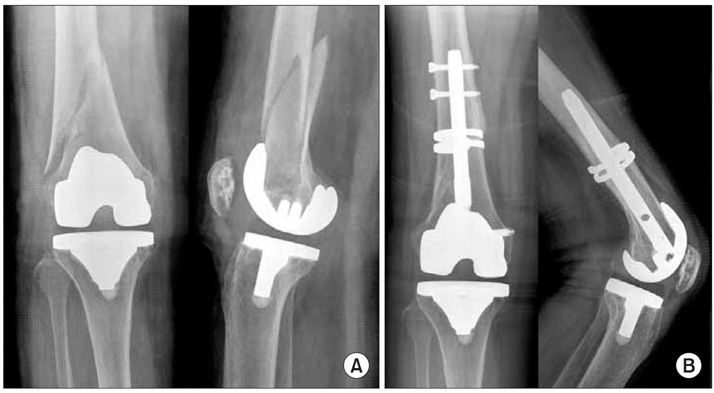Clin Orthop Surg.
2009 Dec;1(4):201-206. 10.4055/cios.2009.1.4.201.
Retrograde Intramedullary Nailing for Periprosthetic Supracondylar Fractures of the Femur after Total Knee Arthroplasty
- Affiliations
-
- 1Department of Orthopaedic Surgery, Seoul National University Boramae Medical Center, Seoul, Korea. ossbkang@gmail.com
- KMID: 999402
- DOI: http://doi.org/10.4055/cios.2009.1.4.201
Abstract
- BACKGROUND
Periprosthetic supracondylar fractures of the femur after total knee arthroplasty are not common but are usually difficult to treat due to the advanced age of patients and frequently accompanying osteoporosis. Retrograde intramedullary nailing can be effective in promoting healing of these fractures by providing sufficient stability, but the number of beneficiaries is small due to its limited applicability and the postoperative function has rarely been assessed. This study evaluated the efficacy of retrograde intramedullary nailing for the treatment of periprosthetic supracondylar fractures of the femur using the clinical outcomes.
METHODS
Between January 2000 and May 2006, 9 patients (10 knees) with periprosthetic supracondylar fractures of the femur underwent retrograde intramedullary nailing. An open reduction and additional fixation using a shape memory alloy ring were used in 3 of them in whom a closed reduction was not successful. The clinical and radiographic findings were reviewed retrospectively in 7 patients (8 knees), excluding 2 who were unavailable for a follow-up assessment due to death. The mean follow-up period was 39 months (range, 24 to 82 months). The union and alignment of the fracture were assessed radiographically. The postoperative function was evaluated using Sanders' criteria.
RESULTS
Radiographic union was obtained in all patients after an average of 13 weeks (range, 12 to 15 weeks) postoperatively. No postoperative infection, heterotopic ossification and component loosening were observed. After union, the coronal alignment averaged 0.1degrees valgus (range, 3.6degrees varus to 2.6degrees valgus) and the mean sagittal alignment was 1.9degrees of extension (range, 0.9degrees of flexion to 6.3degrees of extension). The mean range of motion was 103degrees (range, 90degrees to 120degrees) postoperatively. At the last follow up, there were 1 excellent, 5 good and 2 fair results according to Sanders' criteria.
CONCLUSIONS
With retrograde intramedullary nailing, excellent fracture union and good functional recovery were obtained in patients with periprosthetic supracondylar fractures.
Keyword
MeSH Terms
Figure
Cited by 2 articles
-
Retrograde Intramedullary Nailing for Distal Femur Fracture with Osteoporosis
Jihyeung Kim, Seung-Baik Kang, Kyungpyo Nam, Seung Hwan Rhee, Jong Won Won, Hyuk-Soo Han
Clin Orthop Surg. 2012;4(4):307-312. doi: 10.4055/cios.2012.4.4.307.The Outcome and Complications of the Locked Plating Management for the Periprosthetic Distal Femur Fractures after a Total Knee Arthroplasty
Ashok S Gavaskar, Naveen Chowdary Tummala, Muthukumar Subramanian
Clin Orthop Surg. 2013;5(2):124-128. doi: 10.4055/cios.2013.5.2.124.
Reference
-
1. Backstein D, Safir O, Gross A. Periprosthetic fractures of the knee. J Arthroplasty. 2007. 22:4 Suppl 1. 45–49.
Article2. Berry DJ. Epidemiology: hip and knee. Orthop Clin North Am. 1999. 30(2):183–190.3. Dennis DA. Periprosthetic fractures following total knee arthroplasty. Instr Course Lect. 2001. 50:379–389.
Article4. Currall VA, Kulkarni M, Harries WJ. Retrograde nailing for supracondylar fracture around total knee replacement: a compatibility study using the Trigen supracondylar nail. Knee. 2007. 14(3):208–211.
Article5. Kim KI, Egol KA, Hozack WJ, Parvizi J. Periprosthetic fractures after total knee arthroplasties. Clin Orthop Relat Res. 2006. (446):167–175.
Article6. Rorabeck CH, Taylor JW. Classification of periprosthetic fractures complicating total knee arthroplasty. Orthop Clin North Am. 1999. 30(2):209–214.
Article7. Sanders R, Swiontkowski M, Rosen H, Helfet D. Double-plating of comminuted, unstable fractures of the distal part of the femur. J Bone Joint Surg Am. 1991. 73(3):341–346.
Article8. Bezwada HP, Neubauer P, Baker J, Israelite CL, Johanson NA. Periprosthetic supracondylar femur fractures following total knee arthroplasty. J Arthroplasty. 2004. 19(4):453–458.
Article9. Bae DK, Yim CM, Kim JM. Treatment of periprosthetic fractures following TKA. J Korean Orthop Assoc. 2000. 35(1):21–26.
Article10. Cain PR, Rubash HE, Wissinger HA, McClain EJ. Periprosthetic femoral fractures following total knee arthroplasty. Clin Orthop Relat Res. 1986. (208):205–214.
Article11. Rorabeck CH, Taylor JW. Periprosthetic fractures of the femur complicating total knee arthroplasty. Orthop Clin North Am. 1999. 30(2):265–277.
Article12. Ricci WM, Borrelli J Jr. Operative management of periprosthetic femur fractures in the elderly using biological fracture reduction and fixation techniques. Injury. 2007. 38:Suppl 3. S53–S58.
Article13. Fulkerson E, Tejwani N, Stuchin S, Egol K. Management of periprosthetic femur fractures with a first generation locking plate. Injury. 2007. 38(8):965–972.
Article14. Ricci WM, Loftus T, Cox C, Borrelli J. Locked plates combined with minimally invasive insertion technique for the treatment of periprosthetic supracondylar femur fractures above a total knee arthroplasty. J Orthop Trauma. 2006. 20(3):190–196.
Article15. Bong MR, Egol KA, Koval KJ, et al. Comparison of the LISS and a retrograde-inserted supracondylar intramedullary nail for fixation of a periprosthetic distal femur fracture proximal to a total knee arthroplasty. J Arthroplasty. 2002. 17(7):876–881.
Article16. Erhardt JB, Grob K, Roderer G, Hoffmann A, Forster TN, Kuster MS. Treatment of periprosthetic femur fractures with the non-contact bridging plate: a new angular stable implant. Arch Orthop Trauma Surg. 2008. 128(4):409–416.
Article17. Yoo MJ, Kim MH, Park HG, Byun WS, Kim KC. Treatment of the distal femur fracture with retrograde intramedullary nailing. J Korean Fracture Soc. 2005. 18(3):238–243.
Article18. Maniar RN, Umlas ME, Rodriguez JA, Ranawat CS. Supracondylar femoral fracture above a PFC posterior cruciate-substituting total knee arthroplasty treated with supracondylar nailing: a unique technical problem. J Arthroplasty. 1996. 11(5):637–639.
Article19. Gliatis J, Megas P, Panagiotopoulos E, Lambiris E. Midterm results of treatment with a retrograde nail for supracondylar periprosthetic fractures of the femur following total knee arthroplasty. J Orthop Trauma. 2005. 19(3):164–170.
Article
- Full Text Links
- Actions
-
Cited
- CITED
-
- Close
- Share
- Similar articles
-
- Treatment for Periprosthetic Supracondylar Femur Fractures Following Total Knee Arthroplasty -Comparative Study of Retrograde Intramedullary Nailing and Locking Compression Plate Fixation-
- Supracondylar Intramedullary Nail for Femoral Supracondylar Fracture following TKA: 3 Cases Report
- Treatment of Periprosthetic Supracondylar Femur Fractures Following Total Knee Arthroplasty
- Midterm Results of Treatment with a Retrograde Nail for Periprosthetic Fractures of the Femur Following Total Knee Arthroplasty
- The Result of Treatment of Femoral Periprosthetic Fractures after Total Knee Arthroplasty


